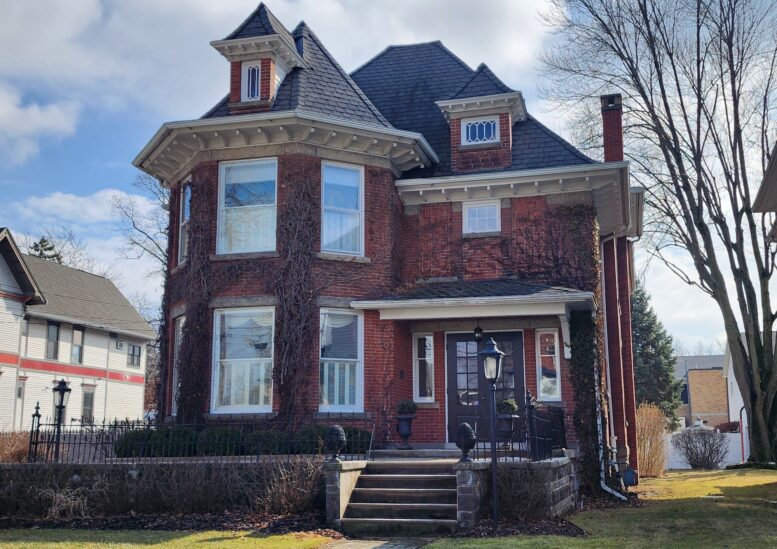The Historic Preservation Commission’s Historic Building of the Month for March and April is the brick home at 315 W. Wooster St. The owner Lee Anne Snook wrote this affectionate piece about her home in 1989, when it was published in Toledo Magazine. This is the second installment. It was edited for length and updated.
Written by Lee Anne Snook
I think of myself as the house’s archivist, and these memories I gather are like pieces of past happiness. They seem to me wonderfully romantic.
I did not grow up in this town, and I envy the long-term relationships which exist among people here. I never really felt like part of a town or a neighborhood before, and this house has furnished me with some roots. I don’t mind that they are borrowed.
I expected to hear a couple of colorful ghost stories connected with the house since Mary Helfrich died here early one January morning in 1932, soon after the sudden death of her son, but so far there has been no sign of restless spirits.
In 100 years’ time, a venerable old home like this one is gilded over and over according to the tastes of each new family. I regret I can’t peel back the layers of flooring and wallpaper to see a century’s worth of interior decoration.
It has been easier to trace the building’s structural changes; discovering this evolution is thrilling for the old-house lover.
We felt our first shiver of excitement several years ago when we came upon an old postcard of Bowling Green from the early 1900s which shows a tantalizing glimpse of our house through a stand of trees. To us, it was like finding a youthful picture of a mysterious and exotic relative.
The house looked raw and naked without the ivy veil the brick now wears for summer shading. But what surprised us more in that early picture was the existence of a squat entry porch now gone from the house, replaced with a more comely stone patio framed with iron railings.
We experienced a second shock of discovery several years later, when we came across old blueprints of the house that were tucked high up in the same closet where I’d found the old box of letters. With anticipation, we unrolled the crinkly drawings which were more momentous to us than the Dead Sea Scrolls.
The blueprints, drawn up for the doctor in the 1940s, showed proposed changes in the house which were later carried out, and which altered the building’s appearance significantly from the way it looked in Mr. Helfrich’s time.
For one thing, the drawings foretold how the façade would change when the entry porch we’d seen on the postcard was removed.
Studying the prints, we realized that our large living room used to be two rooms until a wall that separated the original living room from a small front parlor was removed. We also discovered that the screened porch which runs the length of the dining room was not original to the house, nor was an upstairs bath which stole its space from the front bedroom.
There were other revelations, too. I was surprised to find three small windows marked on the blueprints above the entry porch, and assumed this was an error, since there is only one small window in that location now. But out of curiosity, I went outside to see if I could find any trace of those two vanished windows and with an exhilarating sense of discovery, I realized that the peculiar herringbone-patterned brickwork above the front door, which I had previously supposed was a quirky decorative touch, was actually done to disguise the removal of those windows 40 years before.
The blueprints do not offer a reason for the obvious change in the color of the brick at the back of the house, which hints at an earlier addition. The drawings also fail to confirm the existence of an elevator which was reportedly installed here when the doctor owned the place. Probably the “elevator” is simply a local child’s simplification of the dumbwaiter which was so popular for hide-and-seek games. (Although no longer dumbwaiter doors still exist in the upstairs hall and the attic.)
When I discovered that significant structural changes had been made over the years which I never suspected, I felt an inappropriate sense of betrayal. Here was a house I thought I knew well, and yet it had secrets, like one of those husbands who has other wives in other states. Slowly I have come to accept the fact that this home has belonged to too many; it will never really be mine.
At least the changes have been almost seamless, and done with respect, if not reverence. So far, none of the house’s residents have been seduced by the pitch of an aluminum siding salesman. And we’re not likely to replace our old wavy windows with more energy-efficient ones, even though winter finds us swaddled in sweaters, big and bulky like the Michelin man.
In our forty years of life in this house, my husband and I have done some renovation too—a new kitchen and three bathroom remodels, but since we’re respectful of the house’s integrity, no history was harmed in the making of these changes. We’re hoping that only a few further tweaks will be necessary.
In 130 years’ time, this home has accommodated horsehair sofas and Lucite end tables, gaslight chandeliers and microwave ovens, and has vibrated with the music of Nelson Eddy, Glenn Miller, the Supremes, and U2. Nonetheless, it has maintained an internal constancy which is rare and precious.
Sometimes I wonder: is it perverse to be in love with a building? Because this house has a hold on me that I cannot articulate. The stained-glass window I love in the living room, which projects a rosy fireworks on the floor every morning, has been giving the same dazzling performance for over a century, to five different, delighted families. I hope it will dazzle many more.
With those future residents in mind, I am going to leave something of myself high up on a closet shelf, too. In another hundred years, if the house still stands and the earth still spins, maybe someone will find an old scrapbook of mine. She will strain for the sounds of my laughter, and squint at the quaint photographs of my friends. Maybe then, after her own exploration, she will write her own evocation of this fine and well-loved antique.
(Part One of Snook’s story can be found at https://bgindependentmedia.org/old-brick-beauty-has-lots-of-stories-to-tell-at-315-w-wooster-st-part-1-of-2-installments/)
Would you like to nominate a historic building or site for recognition? You can do this through the city website at – https://www.bgohio.org/FormCenter/Planning-13/Historic-BuildingSite-Nomination-Form-83
You can learn more about the Historic Preservation Commission by attending their meetings (the fourth Tuesday of each month at 4:00 p.m.) or by visiting the webpage at https://www.bgohio.org/436/Historic-Preservation-Commission.

